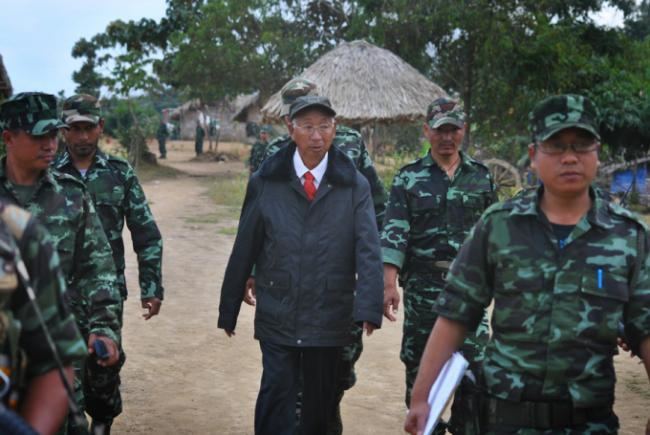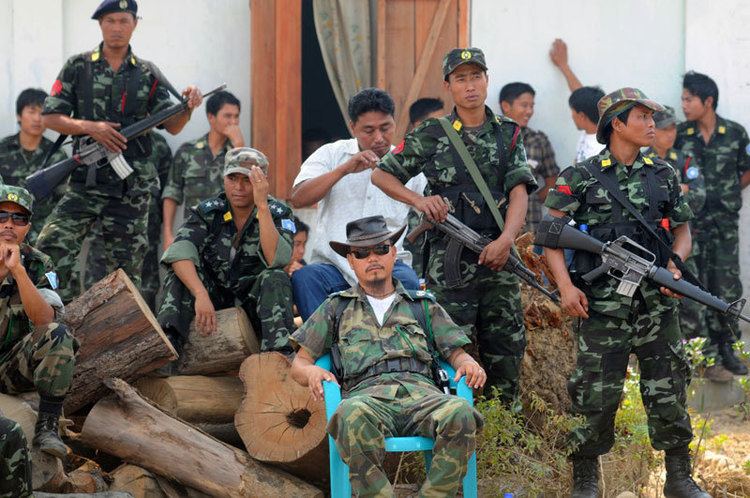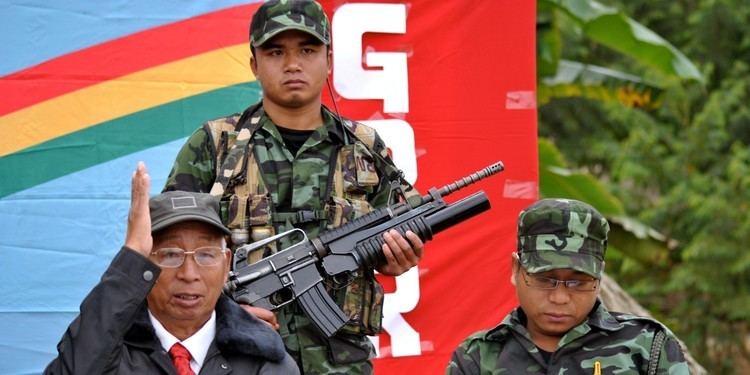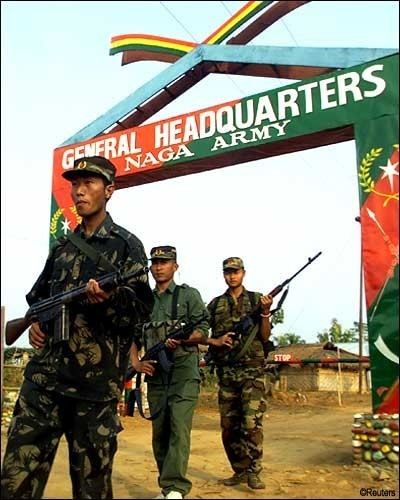Founded 31 January 1980 | ||
 | ||
Active January 31, 1980 (1980-01-31)–present Groups NSCN-IMNSCN-KNSCN-KKNSCN-UNSCN-R (2015–present) Leaders Thuingaleng MuivahS.S. Khaplang Headquarters Hebron CampSuhroto CampJhaluki HidingsOther mobile camps Area of operations Chittagong Hill Tracts, BangladeshManipur, IndiaNagaland, IndiaSagaing Region, Myanmar Areas of operations | ||
Naga nscn another soldier down
The Nationalist Socialist Council of Nagaland (abbreviated NSCN) is a Christian extremist, Naga nationalist insurgent group operating mainly in Northeast India, with minor activities in northwest Myanmar (Burma) until 2012. The main goal of the organisation is to establish a sovereign christian Naga state, "Nagalim", which would consist of all the areas inhabited by the Naga people in Northeast India and Northwest Myanmar.
Contents
- Naga nscn another soldier down
- Formation
- Objective
- Area of operation
- Leadership and structure
- Linkages
- A brief history of Naga insurgency
- Reformation
- References

The NSCN has been designated a terrorist organisation in India under the Unlawful Activities (Prevention) Act, 1967.
Formation

(NSCN) which is the abbreviation for the National Socialist Council of Nagalim was formed on 31 January 1980 by late Isak Chishi Swu who hails from Sumi (Sema) of Naga tribe, Thuingaleng Muivah who hails from Somdal Village of Ukhrul District, the headquarter for the Tangkhul Community and S.S. Khaplang opposing the Shillong Accord signed by the then Naga National Council (NNC) with the Government of India. The name of the Government is called, "The People Republic of Nagaland (Nagalim)". Later, a disagreement surfaced within the outfit leaders over the issue of commencing dialogue with the Indian Government. On 30 April 1988, the NSCN split into two factions; the NSCN-K led by S S Khaplang, and the NSCN-IM, led by Isak Chishi Swu and Thuingaleng Muivah. The split was accompanied by a spate of violence and clashes between the factions.
Objective

The objective of the NSCN was to establish a Sovereign, Christian State by unifying all the Naga-inhabited areas in the North East of India and Northern Burma which the organisation and the people of the area proposed as Nagalim. Unification of all Naga tribes under one administration and 'liberating' Nagalim from India is listed as one of the supposed main objectives of the organisation. Its manifesto is based on the principle of Socialism for economic development and a Baptist Christian religious outlook. In some of their documents the NSCN has called for recognising only the Baptist religion in Nagalim.
Area of operation

NSCN is active in North East India. The state of Nagaland and the hill districts in Manipur inhabited by the Nagas are the main areas where strong influence and presence of the organisation is felt. Its presence in neighbouring states of Assam and Arunachal Pradesh are also widely acknowledged. On the international level, the presence and influence of the NSCN in the Northern part of Myanmar that are inhabited by the Naga tribes dates back to the time when the Nagas started their freedom struggle.
Leadership and structure

Late Isak Chishi Swu and Thuingaleng Muivah, the founding fathers of NSCN-IM, was Chairman and General Secretary of NSCN-IM respectively and SS Khaplang is the Chairman of the NSCN-K.
On the political front, the NSCN-IM has divided its area of influence into 11 regions based on sub-tribe considerations and administrative convenience. In many areas, it runs a parallel government. There are four major ‘Ministries’ – Defence, Home, Finance and Foreign Affairs. Moreover, there are five other Ministries including Education, Information and Publicity, Forests and Minerals, Law and Justice and Religious Affairs. The most prominent among the Ministries is the ‘Home ministry’, which is considered as a replacement of the Indian State government machinery. The heads of 11 administrative regions report to the ‘Home Minister’ (Kilo Kilonser). The devolution of administrative arms of the organisation goes down to the town and village levels in the NSCN-IM’s areas of influence.
The outfit has also established a government-in-exile called the Government of the People’s Republic of Nagaland/Nagalim (GPRN) which, interacts with formal and non-formal world bodies and media. The GPRN sends emissaries abroad to garner support and raise funds for the Naga cause.
Linkages
Over the years, the NSCN-IM has tried to develop extensive linkages both within and outside India. It is alleged that Pakistan and China are providing finance as well as arms and ammunition to NSCN in their fight for independence against the Indian Government. The group was previously backed by India’s intelligence agencies to weaken the main Naga insurgency.
It is believed that NSCN patronised smaller extremists outfits in the North East of India by giving warfare and intelligence trainings and providing logistics for waging war against India.NSCN had also extreme links with its extremist partner ZRF and ZRO.
The government in India's north-eastern state of Tripura says it has evidence that the state's Baptist Church is involved in backing separatist rebels.
The outfit has also opened up contacts with international organizations like the United Nations Human Rights Council in Geneva, Unrepresented Nations and Peoples Organization (UNPO) at the Hague and the UN Working Group on Indigenous Populations (UNWGIP).
China is also instrumental in providing training and arms, which was established after the arrest of the top NSCN IM leader Anthony Shimray. After his arrest by the Indian intelligence agencies he also revealed that he was tasked by Chinese intelligence agencies to collect and gather intelligence on Indian troop deployments in north eastern states of India. Further it is also alleged that NSCN is the major faction that helps many other minor militant outfits in north east and is widely accepted as the main reason of continued insurgency in north eastern states of Indian republic.
A brief history of Naga insurgency
The word "Naga" denotes a conglomeration of ethnic tribes living on the Himalayan Range in Northeast India. Angami, Ao, Chakesang, Konyak, Tangshang (formerly known as Heimi, Pangmi, Tangsa, Wancho, Nocte) Lotha , Pochury, Rengma, Sumi, Maram, Mao, Tangkhul, Thangal, Sangtam, Poumai, Zeliangrong, Phom, Nocte, Maring, etc. are some important sub-tribes of Naga. It is not to be confused with the Hindu Naga (Sadhus).It is the British who brought the several tribes on these Hills under the umbrella of "Naga" probably on the basis of ethnicity founded on their dissimilarity with people in the region.
The origin of Naga Struggle is traced back to the founding of the Naga Club, in Kohima in 1918 by a group of educated Nagas. They submitted a memorandum to the Simon Commission to exclude the Nagas from any constitutional framework of India. With the coming of Angami Zapu Phizo, popularly called as Phizo, the Naga Movement gained momentum in the late 1940s.
Phizo along with some other prominent leaders fought on the side of the Indian National Army (of Netaji Subhash Chandra Bose) under the Japanese command against the Allied Force with the hope of attaining freedom. The Naga Club later became the Naga National Council (NNC) in 1946, the precursor of the NSCN to voice for Naga freedom. Disappointed by the policy frameworks of the Indian National Congress (INC), they went underground and started engaging in guerrilla warfare against Indian Security Forces.
The NNC under Phizo's leadership declared Independence of Nagaland on 14 August 1947. It was greeted with great euphoria which echoed all over the Naga hills. Phizo was arrested in 1948 by the Indian Government on charges of rebellion. On his release, Phizo was made the President of the NNC in 1950. In 1952, he met Jawaharlal Nehru, the then Prime Minister of India to chalk out pathway for Naga's Independence. The meeting was unsuccessful with both the parties remaining steadfast to their view points and demands.
The Indian army then marched in to suppress the rebellion and to track down AZ Phizo, however, Phizo managed to escape to East Pakistan and from there to London, where he remain exiled till his death in 1990. The armed rebellion continued led by a section of the NNC leaders. An agreement was reached by the Indian Government and the NNC in the year 1975. This came to be known as the Shillong Accord, which some leaders in the NNC called as total betrayal including Isak Chishi Swu, Thuingaleng Muivah and SS Khaplang. This led to the formation of the Nationalist Socialist Council of Nagaland or the NSCN in the late 1970s under the leadership of Isak Chishi Swu, Thuingaleng Muivah and SS Khaplang. It started an underground Naga Federal government having both Civil and Military wings. It again split into two factions in the late 1980s: the NSCN (IM) and the NSCN (Khaplang).
Reformation
On 6 April 2015 a new faction NSCN (Reformation) was formed. Y. Wangtin Konyak and P. Tikhak officially announced the formation of a new Naga political group going by the name 'National Socialist Council of Nagaland (Reformation)' or NSCN (R). The decision came after Wangtin Konyak, a senior minister (Kilonser) and personal secretary to Khaplang and Tikhak, the spokesperson of the outfit were expelled by Khaplang after misunderstanding arose over the recent abrogation of ceasefire with the Government of India.
The duo, wanted to continue with the ceasefire maintaining that "violence has never served a good purpose and the Naga political problem can only be resolved through peace and negotiation" while Khaplang had it abrogated because the "14 years of ceasefire between NSCN (K) and India has become a mockery and futile exercise." The primary agenda of the new NSCN-R would be to "develop a sense of brotherhood among the Naga family and to rebuild the trust and faith among the Naga society.
On 3 August 2015 NSCN leader T Muivah signed a peace accord with the Government of India in presence of Prime Minister Narendra Modi, Home Minister Rajnath Singh, and NSA Ajit Doval.
